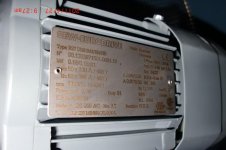Hey all,
I have a Powerflex 40 driving an SEW motor and am having trouble getting the motor to run at the speed I want.
The label on the motor is attached, and I admit that I'm having difficulty interpreting this label, so I may have misinterpreted it. It is attached.
Set up for 50Hz, am I supposed to interpret this label as reading: at 50Hz, I will get 51RPM? Because that is the base scale I am using.
If so, problem is that I am not getting a proportional speed output when using that scale (when I lower the Hz, I am actually getting a lower RPM than expected, and vice versa).
Any ideas?
Thanks in advance for any feedback!

I have a Powerflex 40 driving an SEW motor and am having trouble getting the motor to run at the speed I want.
The label on the motor is attached, and I admit that I'm having difficulty interpreting this label, so I may have misinterpreted it. It is attached.
Set up for 50Hz, am I supposed to interpret this label as reading: at 50Hz, I will get 51RPM? Because that is the base scale I am using.
If so, problem is that I am not getting a proportional speed output when using that scale (when I lower the Hz, I am actually getting a lower RPM than expected, and vice versa).
Any ideas?
Thanks in advance for any feedback!






